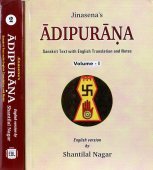Shubhacandra, Śubhacandra: 3 definitions
Introduction:
Shubhacandra means something in Jainism, Prakrit, Hinduism, Sanskrit. If you want to know the exact meaning, history, etymology or English translation of this term then check out the descriptions on this page. Add your comment or reference to a book if you want to contribute to this summary article.
The Sanskrit term Śubhacandra can be transliterated into English as Subhacandra or Shubhacandra, using the IAST transliteration scheme (?).
Alternative spellings of this word include Shubhachandra.
In Jainism
General definition (in Jainism)
Source: The University of Sydney: A study of the Twelve ReflectionsŚubhacandra (शुभचन्द्र) is the author of the 11th century Jñānārṇava (also Dhyānaśāstra), a treatise on Jain Yoga in roughly 2200 Sanskrit verses.—Śubhacandra’s time and the precise date of composition of the Jñānārṇava are unknown so that they are still largely a matter of conjecture. A negligible amount has been written in English about Śubhacandra and what has been written lacks consistency. Most scholars writing in English have surmised that the author of the Jñānārṇava lived in the tenth or eleventh century C.E.

Jainism is an Indian religion of Dharma whose doctrine revolves around harmlessness (ahimsa) towards every living being. The two major branches (Digambara and Svetambara) of Jainism stimulate self-control (or, shramana, ‘self-reliance’) and spiritual development through a path of peace for the soul to progess to the ultimate goal.
Languages of India and abroad
Sanskrit dictionary
Source: Cologne Digital Sanskrit Dictionaries: Aufrecht Catalogus CatalogorumŚubhacandra (शुभचन्द्र) as mentioned in Aufrecht’s Catalogus Catalogorum:—Śabdacintāmaṇivṛtti. In Proceed. Asb. 1875, 77 a Prākṛt grammar is mentioned called Audāryacintāmaṇi by Śubhasāgara, which may be identical with the present work. But I doubt whether the name Śubhasāgara has ever been heard of by any one else but my honoured friend Mitra.
Source: Cologne Digital Sanskrit Dictionaries: Monier-Williams Sanskrit-English DictionaryŚubhacandra (शुभचन्द्र):—[=śubha-candra] [from śubha > śubh] m. Name of the author of the Śabda-cintāmaṇi-vṛtti, [Catalogue(s)]
Sanskrit, also spelled संस्कृतम् (saṃskṛtam), is an ancient language of India commonly seen as the grandmother of the Indo-European language family (even English!). Closely allied with Prakrit and Pali, Sanskrit is more exhaustive in both grammar and terms and has the most extensive collection of literature in the world, greatly surpassing its sister-languages Greek and Latin.
See also (Relevant definitions)
Partial matches: Shubha, Candra.
Full-text (+2553): Jnanarnava, Shabdacintamanivritti, Nayavilasa, Shravakajana, Vinashvarata, Sujana, Shuddhyartha, Padastha, Manojnavishaya, Vancana, Shravanartha, Shravana, Svapna, Mulasutra, Svashravana, Manojna, Vyavasthita, Svapnasamnibha, Ashirvada, Vancanoddhata.
Relevant text
Search found 2 books and stories containing Shubhacandra, Śubhacandra, Subhacandra, Shubha-candra, Śubha-candra, Subha-candra; (plurals include: Shubhacandras, Śubhacandras, Subhacandras, candras). You can also click to the full overview containing English textual excerpts. Below are direct links for the most relevant articles:
Yogadrstisamuccaya of Haribhadra Suri (Study) (by Riddhi J. Shah)
Chapter 6.1 - Influence of the Yogadṛṣṭisamuccaya (Introduction) < [Chapter 6 - Influence of the Yogadṛṣṭisamuccaya]
Chapter 1.4 - From Haribhadrasūri to Hemacandrācārya (Hemachandra) < [Chapter 1 - The Jain Yoga Tradition—A Historical Review]
Chapter 1.8 - The Goal in Jain Yoga < [Chapter 1 - The Jain Yoga Tradition—A Historical Review]
Tattvartha Sutra (with commentary) (by Vijay K. Jain)
Related products
